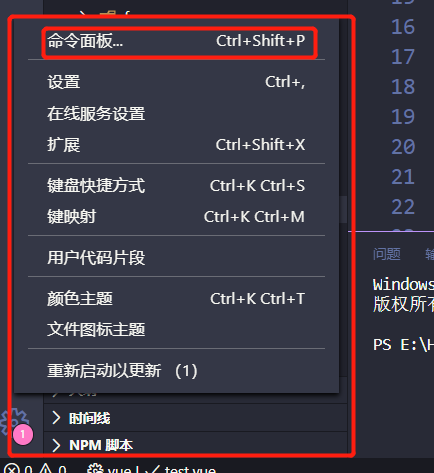手把手--vs code 自定义快捷模块输入
直接进入话题,手把手自己教自己配置VS code 自定义快捷模块【不要看向我,用了一段时间现在才学,太渣了】
打开vscode编辑器
第一部分:自定义快捷模块操作
1.打开命令面板
快捷键 ctrl+shift+p

2.输入snippets 搜索

回车选中

定义代码段名称【tem】

回车会打开一个文件,该文件就是用来存放自定义模块的代码【tem.code-snippets】
第二部分:自定义快捷模块内容配置
1.内容配置规则
参数说明
prefix:使用代码段的快捷入口body:需要设置的代码放在这里,字符串间换行的话使用\r\n换行符隔开.如果值里包含特殊字符需要进行转义,多行代码以","分隔(在引号后面写逗号)$0:定义最终光标位置$1:定义第一次光标位置,按tab键可进行快速切换, 还可以有$2,$3,$4,$5...description:代码段描述,在使用智能感知时的描述
我这边自己定义一个vue模块 代码如下
1 // 自定义(vue页面结构) 2 { 3 "vue": { 4 "prefix": "vue-tem", // 设置的快捷入口 5 "body": [ // 模块内容 6 "<!-- $1 -->", // 光标 7 "<template>", 8 " <div>", 9 " $2", 10 " </div>", 11 "</template>", 12 "", 13 "<script>", 14 " export default {", 15 " name: '',", 16 " components: {", 17 " ", 18 " },", 19 " props: {", 20 " ", 21 " },", 22 " data() {", 23 " return {", 24 " ", 25 " }", 26 " },", 27 " computed: {", 28 " ", 29 " },", 30 " created() {", 31 " ", 32 " },", 33 " methods: {", 34 " ", 35 " },", 36 " watch: {", 37 " ", 38 " },", 39 " }", 40 "</script>", 41 "", 42 "<style scoped lang=''>", 43 " ", 44 "</style>" 45 ], 46 "description": "Vue templet" // 说明 47 } 48 }
然后打开任意一个空白vue文件,输入vue-tem,回车直接生成自定义body内的代码,不重复贴出来了。【懒~】【到这步肯定知道咋操作了】

参考链接 https://www.cnblogs.com/shenxianhui/p/9361957.html
第三部: 定义已有的文件
让我们把时间线回到第一步,输入snippets时,不要定义文件,直接输入vue(html ,JavaScript等也可以)
打开vue.json 文件(我是直接默认这个了)
定义模块内容,这里定义了console【原模板已有,放开注释即可 = . =】
{ // Place your snippets for vue here. Each snippet is defined under a snippet name and has a prefix, body and // description. The prefix is what is used to trigger the snippet and the body will be expanded and inserted. Possible variables are: // $1, $2 for tab stops, $0 for the final cursor position, and ${1:label}, ${2:another} for placeholders. Placeholders with the // same ids are connected. // Example: "Print to console": { "prefix": "log", "body": [ "console.log('$1')", "$2" ], "description": "Log output to console" }, }



